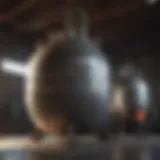Mastering the Art of Selecting Rat Traps Effectively


Overview of Topic
When it comes to maintaining a comfortable and safe home, the unseen threats posed by pests often take center stage. Among these nuisances, rats can become not only a significant inconvenience but also a health hazard. Addressing rodent infestations effectively is crucial for both peace of mind and the overall integrity of your living space.
Effective rat traps play a vital role in pest control, allowing homeowners to manage and eliminate infestations with precision. Choosing the right type of trap is not solely about eliminating the problem, but also about understanding the behavior of these creatures. Rats are intelligent and cautious animals; thus, a mere trap isn't enough. However, knowing the reason behind their intrusion can aid in tailoring a strategic approach to prevent them from making themselves at home.
In this article, we’ll explore the intricate web of selecting and utilizing the most effective rat traps. The significance of these traps extends beyond just catching rats; it encompasses a broader strategy for maintaining hygiene and safeguarding our homes from further threats.
Common Challenges and Solutions
Common Issues Faced by Homeowners
Homeowners often grapple with several challenges when it comes to rodent control.
- Identification of Infestation: The initial struggle usually starts with identifying the presence of rats, which can often go unnoticed until significant damage has already occurred.
- Lack of Knowledge: Many homeowners feel overwhelmed by the myriad of traps available. Selecting the appropriate type can be daunting.
- Effective Placement: Even the best traps yield little success if they are not placed correctly, as rats are naturally cautious.
- Fear of Harm: For those who may be squeamish about the idea of killing rats, the choice of humane traps can often feel limited.
Solutions and Tips to Overcome These Challenges
- Regular Inspections: Keeping a vigilant eye on potential entry points, especially in kitchens and basements, can help identify rat activity early.
- Educative Resources: Leverage online platforms like Reddit and Wikipedia to familiarize yourself with various types of traps.
- Strategic Setup: Make sure to place traps in areas where rat activity has been observed, ideally along walls or in dark corners, as rats prefer to travel along paths where they feel concealed.
- Humane Options: Explore traps that allow live capture, ensuring safe release, maintaining ethical rodent control.
"Understanding the behavior of rats and adapting your approach can change the game in pest control."
Product Recommendations
When it comes to choosing rat traps, a discerning homeowner might consider several key options in the market:
- Victor Electronic Rat Trap
This trap utilizes a high-voltage shock to quickly eliminate rodents, making it a clean and efficient choice. - Tomcat Rat Glue Traps
These adhesive traps can capture multiple rats at once, and they are easy to use in tight spaces. - Kat Sense Humane Live Trap
A prime choice for those preferring non-lethal methods, allowing for safe relocation of captured rats.
Benefits and Features of Recommended Products
- Victor Electronic Trap: Rapid and clean kill, easy to set up, and reusable, which makes it cost-effective long-term.
- Tomcat Glue Traps: Very simple to use without any complex mechanisms, making them ideal for homeowners in a hurry.
- Kat Sense Trap: Offers peace of mind, allowing for humane treatment of pests, and can be used outdoors as well as inside.
Step-by-Step Guides
Practical Steps to Implement Improvements
Here’s a concise guide to properly managing rat infestations using traps effectively:
- Identify Problem Areas: Look for signs of rats, such as droppings or gnaw marks.
- Choose the Right Trap: Based on your tolerance for killing versus live capture, select from the recommended products above.
- Place the Traps Strategically: Set traps where you see signs of activity. Along walls and behind furniture is often best.
- Regularly Check Traps: Monitor traps like a hawk, especially live traps or electronic traps to handle captured rats promptly.
- Seal Entry Points: Once you have managed to catch or eliminate the rats, fortify your home against future invasions by sealing holes or cracks.
By following these steps, you can not only tackle the current infestation but also establish barriers to deter rats from making a reappearance. Effective rodent control demands informed decisions and actions tailored to the specific needs of your home.
Preamble to Rat Control
Rat control is a fundamental aspect of maintaining a healthy and safe living environment. Without a doubt, the presence of these pests can lead to serious health issues and property damage. This section equips readers with essential knowledge about why understanding the rat problem is vital and the specific methods for effective control.
Understanding the Rat Problem
Rats are not merely a nuisance; they pose significant risks due to their behaviors and habits. These creatures can multiply at a staggering rate, with a single female rat producing up to 2,000 offspring in its lifetime. Whether they are Norway or roof rats, their presence can change from a rare sighting to an overwhelming infestation in just a few months.
Identifying the telltale signs of a rat infestation, such as droppings, gnaw marks, and nesting materials, is crucial. This awareness is the first step toward effective control. Homeowners and housewives must understand that rats thrive in environments with easy access to food, shelter, and water. Consequently, keeping food tightly sealed, maintaining cleanliness, and eliminating standing water can significantly deter these pests before they become established.
The Importance of Effective Control Methods
When it comes to tackling a rat problem, employing effective control methods is non-negotiable. The consequences of failed attempts to manage rat populations extend beyond lingering pests. It can lead to increased property damage, contamination of food supplies, and crises of public health.
- Health Risks: Rats are known carriers of diseases like leptospirosis, hantavirus, and salmonella, making it essential to act swiftly.
- Property Damage: Their gnawing habits not only cause direct property damage but may also lead to electrical and fire hazards.
- Psychological Impact: Living under the constant threat of an infestation can impact mental well-being, increasing anxiety for household members.
Knowing the right tools and strategies to combat rats can alleviate these fears. This article delves into various traps, addressing their functionalities and effectiveness. It also explores the importance of preventing infestations before they spiral out of control.
Types of Rat Traps
When it comes to tackling a rat problem, understanding the different types of traps is crucial. The variety of traps available each bring their unique mechanisms and effectiveness to the table, as well as specific benefits and considerations that homeowners should weigh before making a choice. By familiarizing oneself with options like snap traps, electronic traps, live-capture traps, and glue traps, a homeowner can find a solution that not only fits their needs but also aligns with their ethical viewpoints and safety considerations. Let’s delve into these kinds of traps and see how each one fits into the larger puzzle of effective pest control.
Snap Traps: Mechanisms and Effectiveness
Snap traps, often regarded as classics in the pest control arsenal, operate on a simple yet effective mechanism. The basic construct is a metal bar that snaps down with considerable force when triggered, swiftly dealing with the intruder. The effectiveness of these traps often hinges on their correct placement and baiting strategies. What sets them apart is not merely the mechanism but also the ease with which they can be loaded and set. Many of these traps are designed with safety in mind, featuring a bait cup that makes it straightforward to load the bait without putting one's fingers in danger.
Key Benefits:
- Quick kill, minimizes suffering.
- Easy to set and economical.
- Non-toxic, posing no hazards to children or pets when placed thoughtfully.


However, snap traps require diligence in monitoring. If left unattended, they could attract unwanted attention from other pets or, worse, children. It's wise to check them often, especially in a household with active toddlers or pets.
Electronic Traps: A Modern Solution
Electronic traps introduce a high-tech twist to the traditional rat-catching approach. They deliver a quick, humane electric shock to the rodent when it enters the trap, killing it almost instantaneously. This method eliminates the need for messy cleanup, as these traps can be reset without any sort of physical handling of the rodent. Some models even come with smart technology that can alert you via an app when a rat has been caught.
The convenience of these traps cannot be overstated. Many homeowners appreciate the cleaner and more modern method of pest control that electronic traps offer. They require careful placement as well, necessitating a power source nearby and considerations about weather if being used outdoors.
Advantages of Electronic Traps:
- Quick and humane kill.
- Easy to reset; minimal contact with the rodent.
- Some models include alert systems for monitoring.
However, the initial investment might be a bit steeper compared to classic traps. Despite the cost, many users find the benefits outweigh the expense in the long run.
Live-Capture Traps: Ethical Considerations
Live-capture traps provide a different perspective by allowing for the rodent to be caught without harm. Relying on a mechanism that keeps the rat alive, they can later be relocated in a safe area far from the home. This approach can be appealing for those who prioritize humane treatment of animals and want to avoid lethal methods.
While live traps are indeed a gentler option, several factors must be taken into account. For instance, it’s essential to check the traps frequently to avoid undue stress on the rat, and local laws regarding trapping and releasing wildlife must be observed. The traps should be placed in areas where rodents are likely to travel, and homeowners also need to think about where they will release the captured animals, ensuring it’s a suitable environment for them to thrive.
Key Aspects of Live-Capture Traps:
- Provides a humane option.
- Allows for relocation of the rodent.
- Requires regular monitoring and compliance with legal regulations.
Glue Traps: Controversial Yet Used
Glue traps are a contentious topic within pest control circles. They consist of a sticky pad that ensnares the rodent upon contact. While effective in capturing pests, concerns arise regarding the ethics of where these traps can sometimes lead to prolonged suffering for the caught animal. Some might argue they offer a hassle-free method for capturing rats without the risk of accidental injury to pets or children—after all, there's no snapping action.
The use of glue traps may attract debates among homeowners. Although they can be efficient, particularly in spaces where other traps might be less successful, the potential for prolonged suffering can weigh heavily on individuals who are morally opposed to such practices.
Considerations with Glue Traps:
- Simple to use and set up.
- No risk of snap injury.
- Raises ethical concerns about humane treatment.
In summary, understanding the types of rat traps available is an integral element in the fight against rodent infestations. Each trap type has its strengths and weaknesses, making it essential for homeowners to consider their values, effectiveness, and overall suitability for their specific situation.
Key Features of Good Rat Traps
Choosing the right rat trap goes beyond just picking one off the shelf. A good rat trap must possess certain key features that not only determine its effectiveness but also ensure a hassle-free experience for those who use it. Understanding these features equips homeowners and housewives with the knowledge to make the best choice for their specific needs, ultimately leading to a more effective rat control strategy. The following sub-sections will delve into each crucial aspect, shedding light on why they matter.
Durability and Materials
When it comes to rat traps, durability can make or break the experience. Rodent control is not a one-time affair; critters can be persistent, returning time and again if conditions favor them. Thus, a trap should be made from robust materials capable of standing the test of time. Strong plastics or rust-resistant metals often serve as the best materials, ensuring traps withstand repeated use and exposure to varying environmental factors.
The lifespan of a trap can be significantly affected by its material. A trap built from flimsy parts is bound to fail when you need it most. Opt for traps that advertise their durability. In this instance, spending a bit more on a high-quality device can save you a headache down the road.
Ease of Use and Maintenance
No one wants to fumble about trying to set a trap while feeling a sense of urgency. Traps should come with straightforward instructions that allow for a smooth setup process. A unit that requires a degree in engineering to operate is far from ideal. Ideally, the mechanism should function seamlessly, allowing you to set the trap quickly and confidently.
Furthermore, maintenance is equally vital. Ideally, the traps should be easy to clean and reset. Some models require cumbersome disassembly, which can be frustrating, especially in an active situation. Keeping in mind that you'll likely be repeatedly handling these traps, features like removable bait trays are beneficial, making your overall experience smoother.
Safety for Humans and Pets
In the quest to catch rats, safety should never be kicked to the curb. It's essential to choose traps designed with safety mechanisms that minimize risks to children and pets. Consider traps that enclose the killing mechanism, significantly reducing the chance of accidental activation when a little one or a furry friend wanders too close.
Traps should never compromise the safety of living beings in your home. Before you buy, ask questions or look for reviews about safety features. Investing in a trap that prioritizes safety ultimately brings peace of mind, allowing you to focus on your rodent control efforts without constant worry.
Efficacy Rates and Success Stories
Lastly, what good is a rat trap if it can’t do its job? Efficacy rates provide insight into how well a particular trap performs in real-world conditions. Look for statistics or case studies that reveal a trap’s success rate over time. Often, user reviews can shed light on whether a trap indeed works as claimed.
Take the time to explore success stories shared by other homeowners or pest control experts. When you hear firsthand accounts of others who effectively solved their rat problems using a specific trap, it adds credibility. Achieving a balance of quality, effectiveness, and user satisfaction ultimately leads to a more confident purchase decision.
"Safety, effectiveness, and ease of use—these features are the heart of any good rat trap. Choosing wisely can save you from future headaches."
By focusing on these key features, homeowners can rest assured that their choice in rat traps won’t just be an exercise in futility. You’re not only addressing a pest problem but also investing in a solution that aligns with your safety and efficacy standards.
Identifying Optimal Placement
When it comes to effective pest control, the placement of rat traps can make or break your efforts. Identifying the right locations significantly boosts your chances of catching these unwelcome guests. Not only do proper placements attract rats more efficiently, but they also minimize the chances of traps being ignored or triggered incorrectly. This aspect of rat control is paramount; without it, you might find yourself wasting time and resources on ineffective strategies.


Key Areas for Placement
Near Nesting Sites
Placing traps near nesting sites stands out as a fundamental strategy. Rats prefer environments close to their breeding areas, making this a crucial spot. Typically, nesting locations are characterized by signs like droppings or shredded materials, which can guide your placement decisions.
Key characteristic: High likelihood of capture due to proximity to a food source and safety from potential predators.
The proximity of traps to such areas can multiply your success rates as they are more likely to cross paths with your traps on their nightly foraging expeditions. However, one must bear in mind that while traps near nesting sites are beneficial, they must also be monitored closely to ensure they are checked regularly. This constant vigilance reduces the risk of decomposing rodents creating an unpleasant odor in your home.
Along Rat Pathways
Setting traps along rat pathways is another effective strategy. Rats follow particular routes to access food, water, and shelter. These pathways are often identified by visible wear in grass, dirt, or other surfaces.
Key characteristic: Consistency in paths shows where rat activity is concentrated, providing a targeted approach to trapping.
- Advantage: By positioning traps along these pathways, you increase the likelihood of immediate encounters with the traps.
- Disadvantage: If the paths shift due to changes in food availability, you may need to adapt your strategy by relocating traps periodically.
In Areas with Signs of Activity
Identifying locations with evidence of overt rat activity can lead to high catch rates. Look for signs such as droppings, gnaw marks, or even oil smudges along walls where rats have scurried.
Key characteristic: Direct correlation between signs and existing rat presence.
When traps are placed strategically in these locations, the chances of rats encountering them increase significantly. It's an intuitive approach that draws on observational insights. However, relying solely on these signs can sometimes be misleading. The activity may vary continuously based on factors such as seasonal changes or food availability, necessitating a flexible approach to baiting and placement.
Height and Orientation
Height and orientation play crucial roles in trap effectiveness. Rats are surprisingly agile and cunning; they often navigate spaces in ways that humans might overlook.
Placing traps at various heights can ensure their accessibility. Below tables or within low cupboards can be good spots, as rats feel safe operating at lower levels.
Orientation matters too: Aligning traps with the perceived direction of rat movement will increase capture rates. For example, a trap facing a wall rather than open space mimics natural pathways.
Avoiding Common Mistakes
Avoiding pitfalls in trap placement can save you time and effort.
- Ignoring Trapping Locations: Failing to assess areas actively used by rats leads to dead ends.
- Poorly Maintaining Traps: Regular checking is crucial to avoid traps becoming ineffective.
- Incorrect Baiting: Using bait that doesn’t appeal to rats can render an excellent trap useless.
By tweaking these aspects and staying aware of their behavior, success rates can experience a significant upward tick, ensuring you’re not just hoping for a catch, but implementing strategies that result in one.
"Proper placement and thoughtful consideration can increase trap efficacy tremendously!"
Ultimately, the goal of effective rat control revolves around continuous learning and adapting to what works for your unique situation.
Baiting Strategies
Baiting strategies are essential in any rat trapping endeavor, as they greatly influence the success rate of catching these unwelcome guests. The effectiveness of a trap is not only determined by its design but also by the bait used. Proper baiting can lure rats into trap stations, improving capture rates and ultimately helping to resolve an infestation. Choosing the right bait involves considering what attracts these creatures, as well as the environment in which the traps are placed.
Choosing Effective Baits
When it comes to rat trapping, choosing the right type of bait is akin to setting a stage for a performance. What you place there can either summon them or send them running the other way.
Types of Food that Attract Rats
Rats have a sweet tooth and are often drawn to certain food choices. Common baits like peanut butter, bacon, and dried fruit can be particularly effective. Peanut butter stands out due to its strong aroma and sticky consistency, which prevents easy removal by the rats. This means that once they have a taste, they are likely to trigger the trap while trying to enjoy this delectable dish.
On the other hand, dried fruits are sweet and packed with calories, drawing in rats naturally. The key characteristic placing them at the forefront is their availability in most households. The downside, however, is that these can sometimes lead to pests other than rats
Alternative Baiting Options
Beyond traditional food items, there are various alternative baiting options that might also pique a rat's interest. Items like cotton balls soaked in essential oils, particularly peppermint, can be intriguing to rats since they are known to be sensitive to scents. This might not lead to immediate captures like food, but can deter or divert their activities.
In addition, some even dabble in using commercial rodent bait that brands like Tomcat offer, made from substances specifically designed to attract rats. The unique feature about these baits is they are not only alluring but often blend well with the environment, allowing for subtle placements. However, they can also pose risks, particularly if pets or children might come into contact.
Bait Placement Tactics
Even the best bait can fall flat if not placed correctly. The art of bait placement involves understanding rat behaviors and their routing patterns. Here are several tactics to consider:
- Near Burrowing Areas: Placing traps close to known rat burrows can increase the chances of catch.
- Pathways: Observe where rats frequently roam. Setting traps along these pathways with bait will likely result in encounters.
- Low Visibility: Rats are cautious and prefer dark, concealed spaces. Make sure bait placement is discreet to avoid scaring them off.


In summary, proper baiting is a blend of art and science. It involves knowing what draws rats in and how to place that bait effectively. This can significantly enhance your trapping strategy, ultimately leading to a more fruitful endeavor in managing and controlling rat populations.
Preventive Measures Beyond Trapping
In the ongoing battle against rats, relying solely on traps may not cut it. Effective rat control isn't just about eliminating the current furry intruders; it's about preventing future infestations. This section illuminates essential preventive measures that homeowners can adopt, emphasizing that a proactive approach is as important as the immediate solution of trapping rats. Understanding these measures can mean the difference between a one-time encounter and a recurring pest problem.
Beyond trapping, the focus should be on curbing the conditions that invite these pests into homes in the first place. This can save time, money, and undue stress, offering long-term peace of mind.
Sealing Entry Points
Rats can squeeze through surprisingly small holes. An entry point as small as a quarter can allow a rat to scurry inside. Therefore, sealing those gaps becomes a top priority. Start by conducting a thorough inspection of your home. Look for any cracks in walls, gaps around windows, or holes in siding. Pay attention to the areas around utility lines and pipes, as these are often overlooked.
To effectively seal entry points, consider using the following materials:
- Steel wool: Rats have a tough time gnawing through this material.
- Caulk: A durable sealant can fill in smaller cracks.
- Sheet metal: For larger holes or gaps, this provides an impenetrable barrier.
Using these materials, not only do you thwart rats from entering, but you also enhance the overall structural integrity of your home. Sealing entry points significantly reduces chances of future infestations, allowing homeowners to breathe easier, knowing they have measures in place to keep their spaces safe.
"An ounce of prevention is worth a pound of cure."
Maintaining Clean Environments
Next on the agenda is maintaining a clean environment. It's no secret that rats are opportunistic feeders, drawn to leftovers and clutter like moths to a flame. Keeping a tidy home is not just about aesthetics; it’s a crucial step in making your property less attractive to these pests.
Here are some practical tips for maintaining a clean environment:
- Regularly dispose of trash: Ensure that garbage bins are sealed and emptied frequently. Leftover food scraps can act as a welcome mat for rodents.
- Store food properly: Use airtight containers for dry goods. This not only preserves freshness but also prevents rats from sniffing out a midnight snack.
- Yard maintenance: Keep your yard tidy by clearing away debris, such as piles of leaves or unused items. These can provide shelter and food sources for rats.
Creating a clean environment doesn't mean reworking your entire lifestyle. It's about being mindful of habits and making simple adjustments that have lasting impacts. This combination of sealing entry points and maintaining a clean space forms a solid strategy against unwelcome rodent guests, leading to less reliance on traps altogether.
Evaluating Trap Performance
Evaluating the performance of rat traps is a crucial step in ensuring effective rodent control. Many homeowners often find themselves overwhelmed by the options available. Hence, it's essential to focus on specific elements that confirm the efficacy of the traps used and the overall strategy employed. The importance of this evaluation lies in not only assessing whether traps are functioning correctly but also in understanding how well they are performing in their environment.
There are several benefits to a systematic evaluation process:
- Identifying Successful Techniques: Monitoring which traps capture more rats helps in adopting those specific strategies for better results in the future.
- Cost Efficiency: Understanding trap performance can lead to financial savings. If certain traps are not effective, it's better to replace them than to continue spending money on ineffective methods.
- Adjustments and Improvements: Evaluation allows for necessary adjustments. If a particular area has persistent activity without capturing any rats, it might indicate the trap's positioning needs a tweak.
Considering the elements of evaluation after setting traps plays a significant role. It informs the homeowner about areas of improvement and provides insights into a viable plan for continuous monitoring.
Assessing Efficacy Post-Setup
Once the traps are set, it's time to get to work assessing their efficacy. This process involves monitoring both the number of captures and the frequency of interactions with the traps. Here’s how you can effectively assess trap performance:
- Check Captures Regularly: Look over the traps daily. This will not only keep track of effectiveness but also maintain cleanliness in the area.
- Document Observations: Write down data on what traps are catching the most and in which locations. Maintain a log of each trap’s performance to spot trends over time.
- Evaluate Bait Consumption: If bait is taken but no catches occur, this may signal a misjudgment in trap placement or bait choice.
- Inspect Trap Conditions: Make sure traps are functioning without obstructions. Sometimes, weather or other environmental factors can affect performance.
"Regular evaluation creates a proactive approach to pest control, allowing homeowners to stay a step ahead of rodent problems."
Adapting Strategies Based on Results
Analyzing trap performance shouldn’t be a one-time endeavor. Adapting strategies based on the results gathered is where success lies. If you find that certain traps aren’t capturing any rats, don’t hesitate to rethink your plan. Here are steps to consider for adjusting your approach:
- Relocate Traps: If traps yield no results in one position, try shifting them to high-traffic areas or along walls where rats are likely to move.
- Change Baits: If your current bait isn’t attracting, explore alternatives like peanut butter, nuts, or dried fruit. Sometimes, freshness matters, so ensure bait isn’t stale.
- Experiment with Different Traps: If snap traps aren’t working, consider trying electronic traps or even live-capture options.
- Assess Environmental Factors: Look for changes in the environment. Seasons or nearby construction can impact rodent activity levels.
Epilogue: Making Informed Choices
In the landscape of pest control, making informed choices is the bedrock upon which successful rat management rests. Understanding the nuances of different rat traps and their applications goes beyond mere preference; it’s about safeguarding one’s home and health. Choosing the right trap can save both time and resources, proving crucial in areas where infestations can spiral quickly if not checked.
The aspects highlighted throughout this article lay a solid foundation for Households in navigating the often murky waters of rodent control. Each trap, whether a classic snap variant or a more modern electronic option, offers unique benefits and downsides. Knowledge about these can lead to better decisions that minimize suffering for the rats while ensuring the effectiveness needed for a home. Not to forget, the integration of comfortable practices for family and pets provides peace of mind.
Recap of Key Considerations
Before launching into a trapping endeavor, it’s vital to revisit some key takeaways:
- Types of Traps: Different traps serve various functions and effectiveness levels.
- Placement: Correct positioning close to signs of rat activity increases trapping success.
- Bait Selection: Knowing what attracts rats can make a world of difference.
- Maintenance: Regular check-ins and upkeep of traps ensure they function when needed.
Choosing wisely based on these factors not only improves effectiveness but also cultivates a safer living environment.
Future Trends in Rat Control Technology
As we look ahead, the world of rat control is poised for innovation. Advanced technologies are emerging, bringing new solutions to age-old problems. Some promising directions include:
- Smart Traps: Devices with sensors can notify homeowners upon catching a rat, offering convenience and prompt action.
- Eco-Friendly Options: With increasing awareness around sustainability, traps that utilize less harmful materials or methods are gaining traction.
- AI and Data Analytics: Predictive technologies could shift how we approach rat control, aiding in more precise location assessments and behavior predictions.
Embracing these advancements not only enhances effectiveness but also aligns with a growing commitment to responsible and ethical pest control.
"The greatest enemy of knowledge is not ignorance, it is the illusion of knowledge."
– Stephen Hawking
In summary, navigating the realm of effective rat traps is not just about selection. It encompasses a holistic approach integrating education, responsibility, and vigilance. By staying informed, homeowners and householders can foster environments that are not only free of rodents but also safe for their families.







